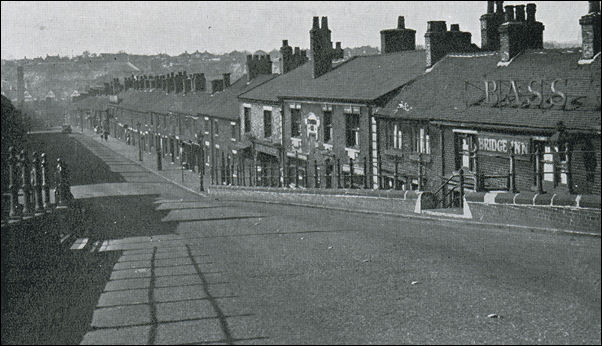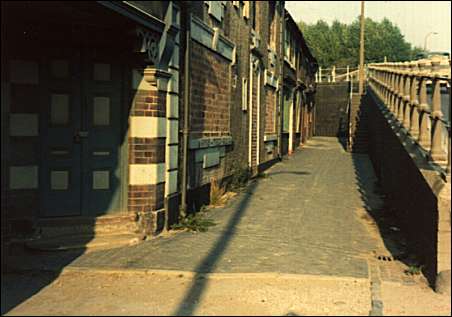|
Lord Street, Etruria
The first houses and the inns:
It was
Thomas Bentley who suggested to Josiah Wedgwood that the workforce should
be accommodated in cottages scattered over the estate but this proposal
was quickly rejected in favour of a simple linear development on the land
below the factory down to the Fowlea Brook. (as usual the works owner
lived on the high ground -Etruria Hall- and the employees lived on the
damp lowland areas).

1877 OS map showing
the first Wedgwood workers houses
on the edge of the works and by the Etruria Inn
The first six houses were built as part of the
factory complex next to the southern roundhouse and probably
accommodated the lodge keeper and key workers such as the firemen.
When the dual carriageway was built the
bridge over the canal was moved away from Lord Street, this is shown by
the fact that on the 1887 map there is a good space between the bridge and
the round house - the MS live search map below shows how close the new
bridge is.

2008 map showing the nearness of the round
house to the bridge
compare this to the 1877 map above

photo of Lord Street taken from the Etruria
Bridge - Warrillow Collection
the Bridge Inn and Etruria Inn on the right
with the first of the workers cottages

The side of the Bridge
Inn - Etruria
This view taken from the
Trent & Mersey Canal - the roadway in front is the road from Lord Street
to the frontage of the Wedgwood factory alongside the canal.

Bridge Inn - at the far
end of the photo

Etruria Inn near to the
camera and Bridge Inn at the far end of the photo
to the right is Lord Street
photos taken 1985 just before demolition
- Ken Green
"Complete with a Methodist Chapel, this street
(Lord Street) which formed the original Etruria contains old-established
shops, many of which have been carried on by the same families for
generations. Here, then, are to be found at least five provision shops ; a
very old established meat trader's business ; a post office that was
occupied until recent years by a lady whose uncle was postmaster before
her (Mrs. B. E. Oldacre, now in well-earned retirement in Wales, was the
first telegraph girl in Etruria and her reminiscences will be found in
other chapters). This Post Office has recently been modernised, but when
last viewed the old bottle glass was still to be seen in one of the
windows of the scullery.
Here, too, will be found the modern shoe shop
kept by an Etruscan famous throughout England for his choral work. In
addition, there is a very old-established cobbler's shop, where one's
shoes may be mended with true Etruscan thoroughness.
The village street is complete with two
barbers' shops and five village inns, namely, the Bridge Inn, now sunk
well below the level of the canal ; the Etruria Inn ; the Lamb at the
corner of Forge Lane ; the Vine ; and the Railway Inn. In addition,
there are several other small shops, perhaps the most interesting of
which is the little gas-lit establishment, still under the name of
Smallwoods, which still deals exclusively in Wedgwood ware, despite the
departure of the firm.
This small shop has sold exquisite Wedgwood ware
for several generations. The pleasantly set out window does not, owing to
prevailing austere conditions, present the splendid array once to be seen,
but it keeps the name of Wedgwood to the forefront in Etruria."
Warrillow - History of Etruria 1952
|